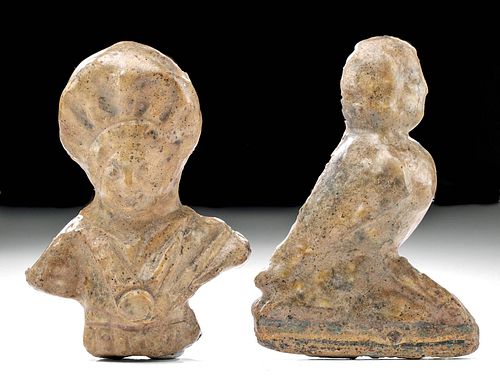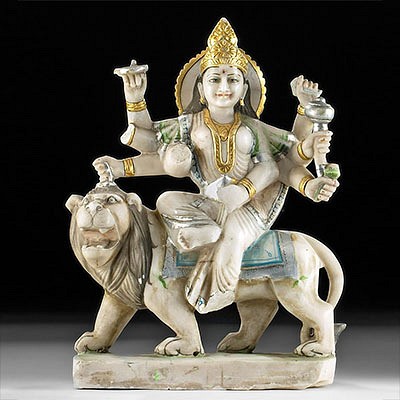Two Egyptian Ptolemaic Glass Inlays - Isis & Ba Bird
Lot 7a
About Seller
Artemis Fine Arts
686 S Taylor Ave, Ste 106
Louisville, CO 80027
United States
Selling antiquities, ancient and ethnographic art online since 1993, Artemis Gallery specializes in Classical Antiquities (Egyptian, Greek, Roman, Near Eastern), Asian, Pre-Columbian, African / Tribal / Oceanographic art. Our extensive inventory includes pottery, stone, metal, wood, glass and textil...Read more
Categories
Estimate:
$1,800 - $2,500
Absentee vs Live bid
Two ways to bid:
- Leave a max absentee bid and the platform will bid on your behalf up to your maximum bid during the live auction.
- Bid live during the auction and your bids will be submitted real-time to the auctioneer.
Bid Increments
| Price | Bid Increment |
|---|---|
| $0 | $25 |
| $300 | $50 |
| $1,000 | $100 |
| $2,000 | $250 |
| $5,000 | $500 |
| $10,000 | $1,000 |
| $20,000 | $2,500 |
| $50,000 | $5,000 |
| $100,000 | $10,000 |
| $200,000 | $20,000 |
About Auction
By Artemis Fine Arts
Jul 16, 2020
Set Reminder
2020-07-16 10:00:00
2020-07-16 10:00:00
America/New_York
Bidsquare
Bidsquare : Ancient / Ethnographic Art Through The Ages
https://www.bidsquare.com/auctions/artemis-gallery/ancient-ethnographic-art-through-the-ages-5334
Ancient art from Egypt, Greece, Italy and the Near East, as well as Asian, Fossils, Pre-Columbian, Native American, African / Tribal / Oceanic, Spanish Colonial, Russian Icons, Fine art, much more! Artemis Fine Arts info@artemisfinearts.com
Ancient art from Egypt, Greece, Italy and the Near East, as well as Asian, Fossils, Pre-Columbian, Native American, African / Tribal / Oceanic, Spanish Colonial, Russian Icons, Fine art, much more! Artemis Fine Arts info@artemisfinearts.com
- Lot Description
Egypt, Ptolemaic to early Romano-Egyptian period, ca. 332 BCE to 1st century CE. A fabulous ensemble of two mold-formed glass appliques in soft hues of citrine, crimson, marigold, and turquoise. The first applique depicts a bust of the goddess Isis wearing a wavy vestment, a large circular pectoral medallion, and a radiant visage above her feminine visage. The second applique illustrates a right facing, human-headed avian effigy, known as a Ba Bird, with a rounded chest bearing folded wings while standing atop an integral plinth. Appliques like these examples were meant to be set into recessed cavities adorning limestone reliefs or wooden coffins and were created throughout the Ptolemaic and Romano-Egyptian periods. Size of largest (ba bird): 2.2" W x 3.125" H (5.6 cm x 7.9 cm)
The images of Isis and the Ba Bird were highly symbolic in Egyptian culture and particularly so when concerning their storied funerary traditions. According to the University of Southern California West Semitic Research Project, "Isis, along with her husband and brother, Osiris, was most often associated with the funerary cult and the afterlife. Together with three other goddesses, she was thought to guard the internal organs of a deceased person at the time of judgment." Though Isis and her companions protected the physical remains of an immobile mummy, one half of the deceased's soul was still able to traverse between the spiritual and corporeal realms.
In Egyptian visual culture, the Ba is oftentimes depicted as a winged Ba-bird symbolizing the ascension of the soul following death. The Egyptian concept of the Ba involves a free soul that may exist independently from the physical body. Hence, it leaves and reunites with the body when it wishes. Traditionally, the Ba-bird is presented in the vicinity of the mummy - other times it is shown entering or leaving the tomb. In addition, the Ba-bird was understood as the immutable essence of the deceased's soul, and loved ones would leave provisions in burial chambers so that the Ba-bird would be encouraged to visit its body regularly.
Provenance: ex-Dr. Sid Port collection, California, USA, acquired in the 1970s; ex-Norman Blankman collection, New York, USA, acquired in the 1950s in Cairo, Egypt
All items legal to buy/sell under U.S. Statute covering cultural patrimony Code 2600, CHAPTER 14, and are guaranteed to be as described or your money back.
A Certificate of Authenticity will accompany all winning bids.
We ship worldwide and handle all shipping in-house for your convenience.
#146831Both items have been professionally cleaned and conserved. Both items have softening to finer details, fading and minor darkening to original glass color, and small nicks around the peripheries, otherwise intact and excellent. Smooth surfaces and light remains of original colors throughout.Condition
- Shipping Info
-
All shipping is handled in-house for your convenience. Your invoice from Artemis Gallery will include shipping calculation instructions. If in doubt, please inquire BEFORE bidding for estimated shipping costs for individual items.
-
- Buyer's Premium



 EUR
EUR CAD
CAD AUD
AUD GBP
GBP MXN
MXN HKD
HKD CNY
CNY MYR
MYR SEK
SEK SGD
SGD CHF
CHF THB
THB
















